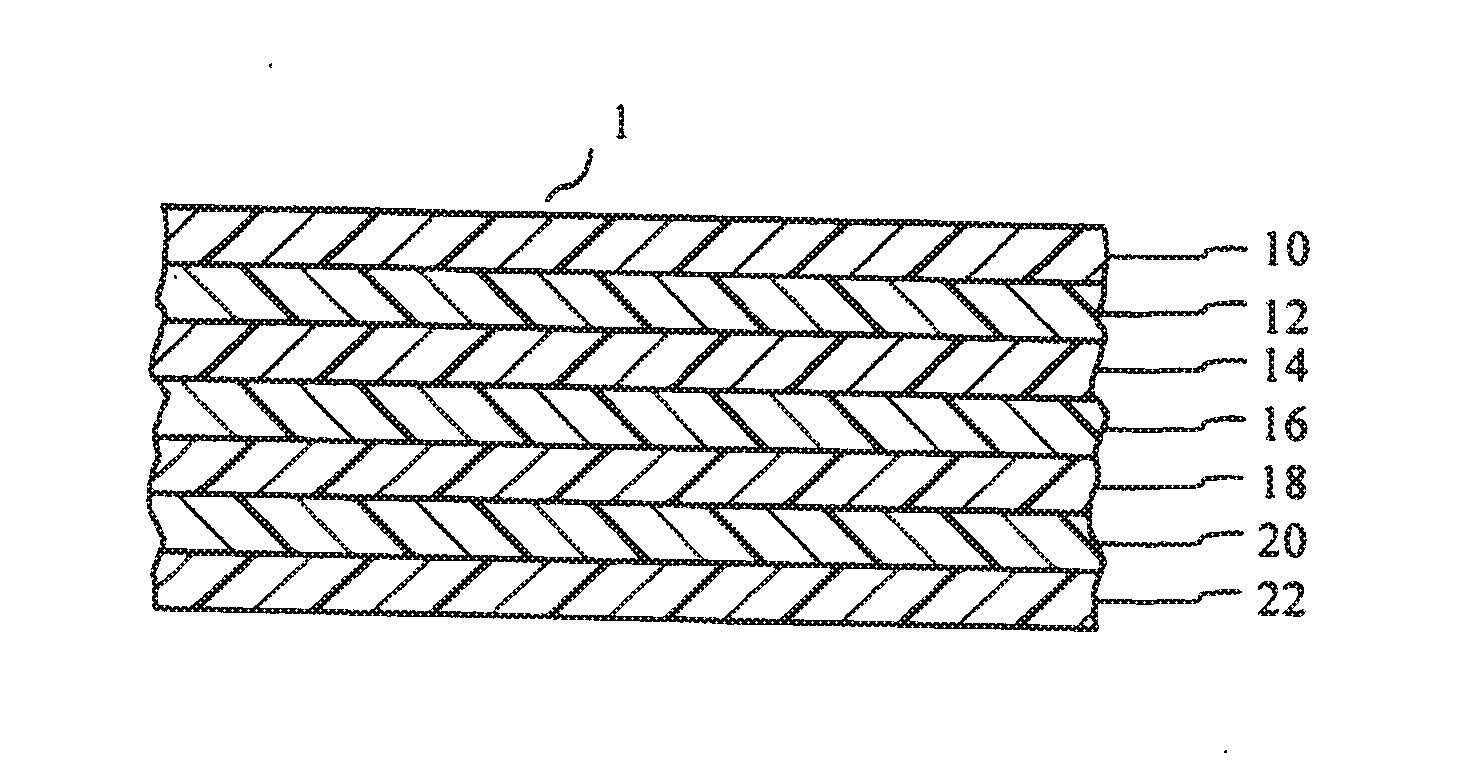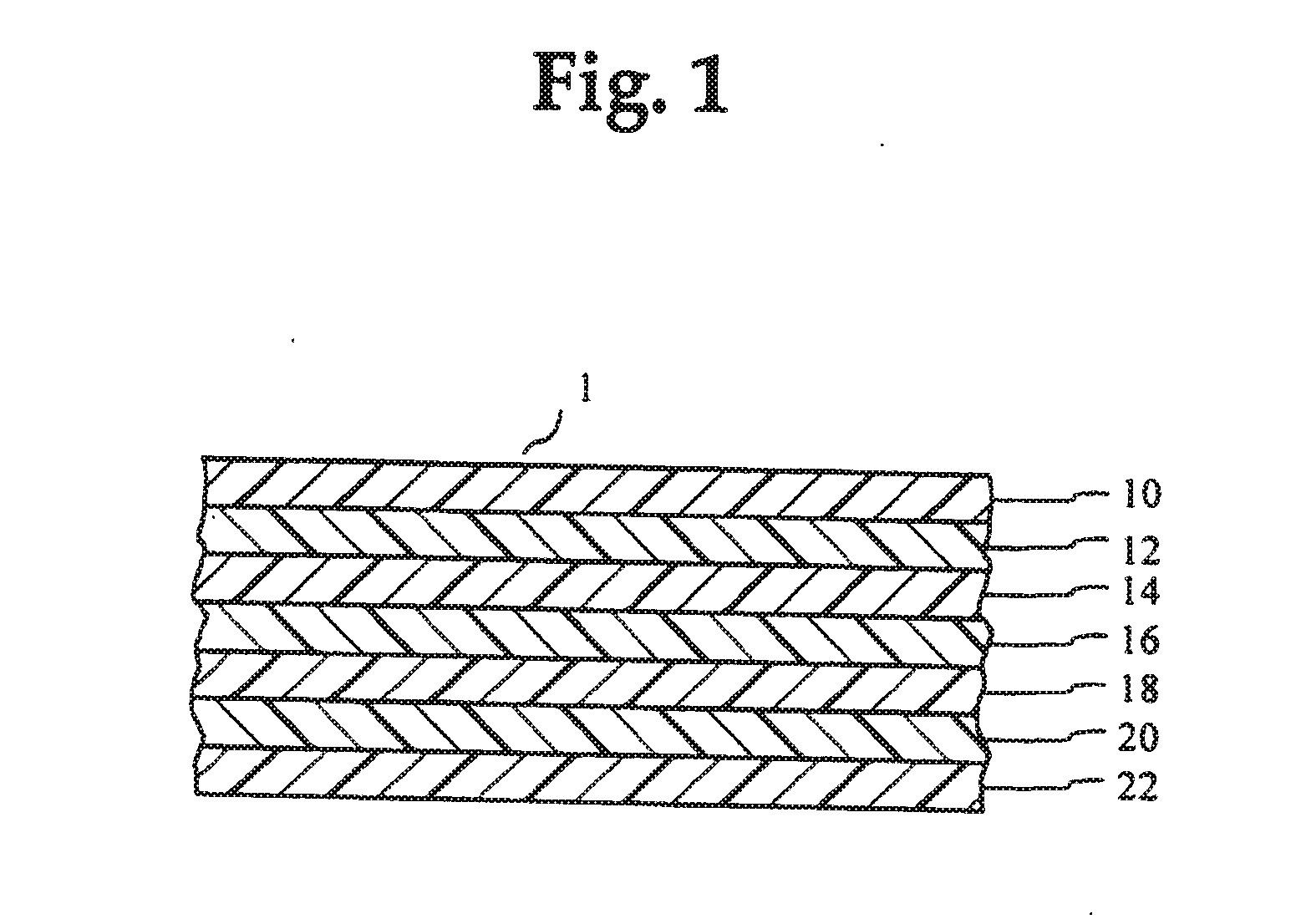Multilayer structures, packages, and methods of making multilayer structures
- Summary
- Abstract
- Description
- Claims
- Application Information
AI Technical Summary
Benefits of technology
Problems solved by technology
Method used
Image
Examples
example 1
[0064]
Percent by volumeMaterials and Structure Layerof structurepercent by weight of layer1 (Outer layer)45.0 80% Nylon 6 20% amorphous polyamide2 (Tie layer)5.0100% anhydride modified LLDPE3 (Polyamide35.0 90% Nylon 6layer) 10% amorphous polyamide4 (Tie layer)5.0100% anhydride modified LLDPE5 (Sealant layer)10.0 50% LLDPE 50% LDPE
[0065]Example 1 illustrates a five-layer structures of the present invention. Specifically, the five-layer structure comprises an outer layer of polyamide, a tie layer of anhydride modified LLDPE, an internal layer of polyamide, such that the outer layer of polyamide and the internal layer of polyamide are disposed adjacent to the tie layer of anhydride modified LLDPE. A second tie layer is disposed adjacent to the internal layer of polyamide, which binds the internal layer of polyamide to the sealant layer of a blend of LLDPE and LDPE.
[0066]In a preferred embodiment of the present invention, seven-layer coextruded structures are provided, as illustrated i...
example 3
[0076]
Percent by volumeMaterials and percent by Structure Layerof structureweight of structure layer1 (Outer)17.5 49% LLDPE 49% LDPE 2% blend of slip and antiblock2 (First Tie)5.0100% anhydride modified LLDPE3 (First20.0 70% nylon 6Polyamide) 25% nylon 6,69 5% amorphous polyamide4 (Second Tie)5.0100% anhydride modified LLDPE5 (Second20.0 70% nylon 6Polyamide) 25% nylon 6,69 5% amorphous polyamide6 (Third Tie)5.0100% anhydride modified LLDPE7 (Sealant)27.5 49% LLDPE 49% LDPE 2% blend of slip and antiblock
[0077]The seven layer structure of Example 3 was made by coextruding the seven layers together and biaxially orienting the structure. The structure had a total orientation factor of about 11.4. In addition, the seven layer structure of Example 3 was annealed to stabilize the final structure. The coextrusion, orientation, and annealing of the seven layer structure of Example 3 were completed in a triple bubble process. The final structure thickness was about 3.7 mils.
[0078]This struct...
example 4
[0079]
Percent by volumeMaterials and percent by Structure Layerof structureweight of structure layer1 (Outer)15.0 49% LLDPE 49% LDPE 2% blend of slip and antiblock2 (First Tie)5.0100% anhydride modified LLDPE3 (First25.0 70% nylon 6Polyamide) 25% nylon 6,69 5% amorphous polyamide4 (Second Tie)5.0100% anhydride modified LLDPE5 (Second25.0 70% nylon 6Polyamide) 25% nylon 6,69 5% amorphous polyamide6 (Third Tie)5.0100% anhydride modified LLDPE7 (Sealant)20.0 49% LLDPE 49% LDPE 2% blend of slip and antiblock
[0080]The seven layer structure of Example 4 was made by coextruding the seven layers together and biaxially orienting the structure. The structure had a total orientation factor of about 9.1. In addition, the seven layer structure of Example 4 was annealed to stabilize the final structure. The coextrusion, orientation, and annealing of the seven layer structure of Example 4 were completed in a triple bubble process. The final structure thickness was about 3.9 mils.
[0081]The seven l...
PUM
| Property | Measurement | Unit |
|---|---|---|
| Thickness | aaaaa | aaaaa |
| Thickness | aaaaa | aaaaa |
| Percent by volume | aaaaa | aaaaa |
Abstract
Description
Claims
Application Information
 Login to view more
Login to view more - R&D Engineer
- R&D Manager
- IP Professional
- Industry Leading Data Capabilities
- Powerful AI technology
- Patent DNA Extraction
Browse by: Latest US Patents, China's latest patents, Technical Efficacy Thesaurus, Application Domain, Technology Topic.
© 2024 PatSnap. All rights reserved.Legal|Privacy policy|Modern Slavery Act Transparency Statement|Sitemap


